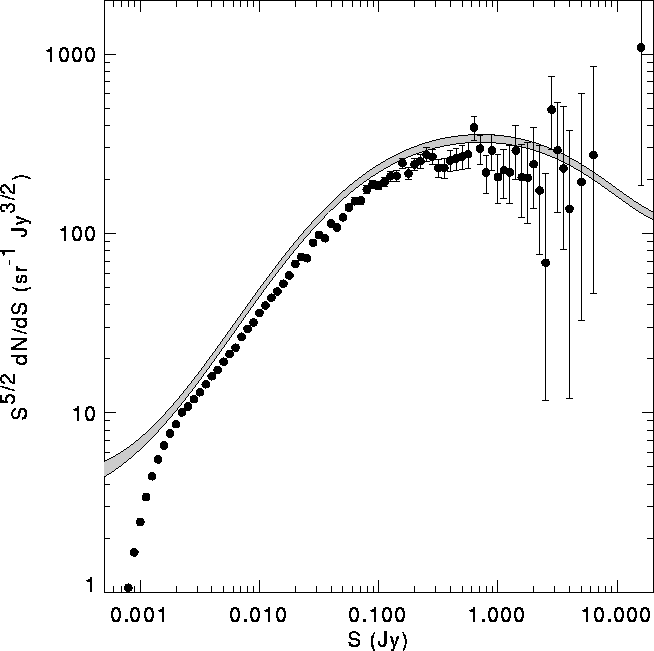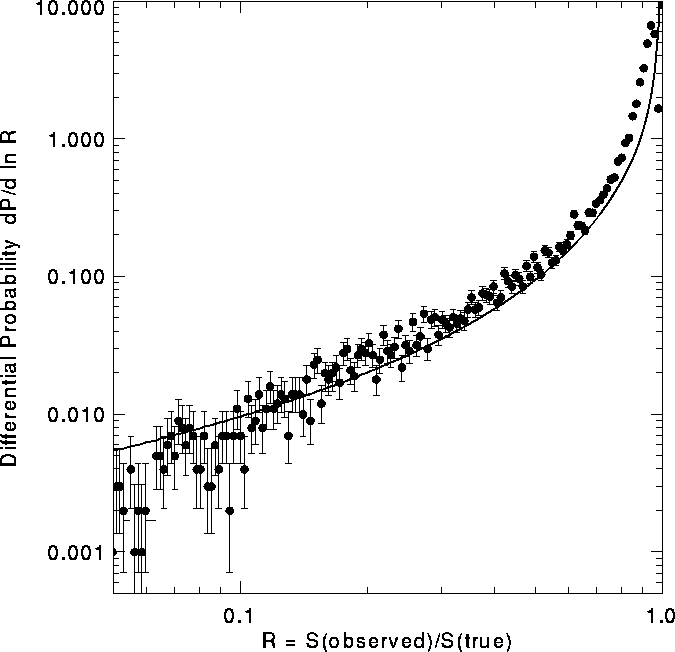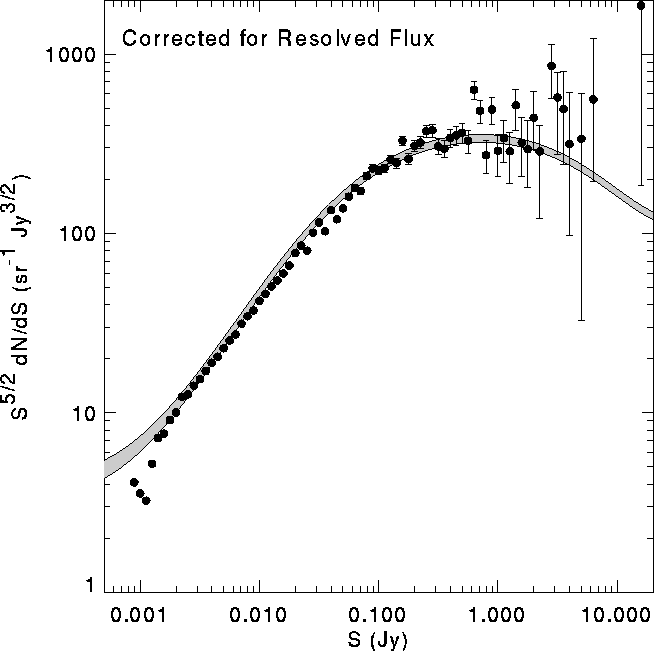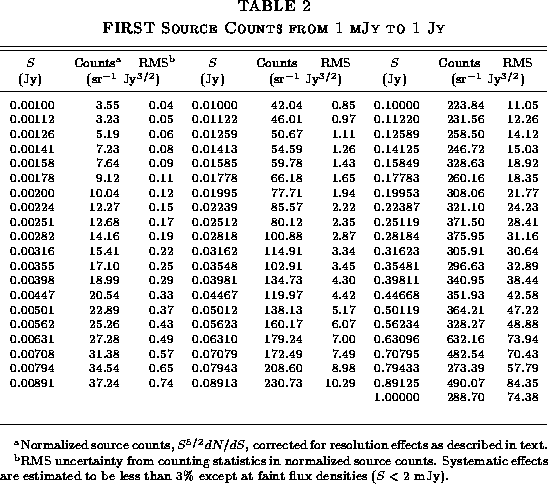The number of sources as a function of flux density is of interest both as a measure of the evolution of cosmic radio sources and also as a powerful test of the completeness and accuracy of the FIRST radio catalog. We have computed the dN/dS distribution of FIRST sources from our catalog for comparison with previous observations of 1.4 GHz source counts.
A number of corrections must be applied to the raw histogram of source
counts versus integrated flux density in order to derive the true
dN/dS. We must first account for the varying sensitivity of the
survey. Each source in the histogram is assigned a weight equal to the
inverse of the area over which the source could have been detected
([Katgert et al. 1973]). We compute this area from the coverage map by
summing the areas of all pixels with rms noise ![]() for
a source with fitted peak flux density
for
a source with fitted peak flux density ![]() before CLEAN bias
correction. Note that sources with
before CLEAN bias
correction. Note that sources with ![]() mJy/beam can be detected
anywhere in the survey area, so the effective area covered is constant
above that peak flux density threshold. However, sources with large
integrated flux densities can still have low peak flux densities, so
the dN/dS histogram is affected by the areal coverage at integrated
flux densities well above this threshold.
mJy/beam can be detected
anywhere in the survey area, so the effective area covered is constant
above that peak flux density threshold. However, sources with large
integrated flux densities can still have low peak flux densities, so
the dN/dS histogram is affected by the areal coverage at integrated
flux densities well above this threshold.
The next step is to combine close groups of sources, which usually are
not independent objects but rather are components of a single object.
To be consistent with previous studies ([Oosterbaan 1978],
[Windhorst et al. 1985]), we have merged sources that fall within
50" of their nearest neighbors. Nearly 30% of the FIRST
catalog entries fall in such groups, which reduces the number of
sources in the dN/dS histogram by ![]() %.
%.
The appropriate weighting for merged sources is somewhat complicated.
Since the sources in a pair have different fluxes, they can have
different associated survey areas over which the sources could have
been detected. Suppose we have two sources with integrated flux
densities ![]() and detection areas
and detection areas ![]() .
In area
.
In area ![]() , both components of this pair are detected; in
area
, both components of this pair are detected; in
area ![]() only the brighter component (source 2) would be detected;
and in the remaining survey area neither component would be
detected. Consequently, for this pair we not only have to add
a contribution to the flux bin
only the brighter component (source 2) would be detected;
and in the remaining survey area neither component would be
detected. Consequently, for this pair we not only have to add
a contribution to the flux bin ![]() , but we also have
to subtract a contribution from bin
, but we also have
to subtract a contribution from bin ![]() to correct
for source pairs where
to correct
for source pairs where ![]() was not detected. The weights
for the pair are
was not detected. The weights
for the pair are ![]() in bin
in bin ![]() and
and ![]() in bin
in bin ![]() . For groups with more than 2 sources,
a contribution is subtracted from several bins representing
partial sums of the brighter source flux densities and added to
the bin that includes the sum of the integrated flux densities of
all components.
. For groups with more than 2 sources,
a contribution is subtracted from several bins representing
partial sums of the brighter source flux densities and added to
the bin that includes the sum of the integrated flux densities of
all components.
Another complication introduced by merging sources is that some
merged sources are not components of a single objects but are independent
objects that happen to fall close together in the sky. The
FIRST catalog has ![]() sources/
sources/ ![]() , so
, so ![]() % of
the sources are expected to have a random neighbor within 50".
Most of the randomly merged sources fall at the faint end of the
flux distribution, since most sources in the catalog are
faint. If the true source distribution is f(S) = dN/dS, then
the observed distribution after random mergers is
% of
the sources are expected to have a random neighbor within 50".
Most of the randomly merged sources fall at the faint end of the
flux distribution, since most sources in the catalog are
faint. If the true source distribution is f(S) = dN/dS, then
the observed distribution after random mergers is
![]()
The function ![]() is the flux distribution of randomly merged groups
containing n sources:
is the flux distribution of randomly merged groups
containing n sources:
![]()
where
![]()
is the distribution of single (unmerged) sources. Here
![]() is
the mean number of sources per merging
area A:
is
the mean number of sources per merging
area A:
![]()
As long as ![]() (as is the case for the FIRST catalog
with a 50" merging radius), a simple way to solve for f(S)
given
(as is the case for the FIRST catalog
with a 50" merging radius), a simple way to solve for f(S)
given ![]() is to use the method of successive substitutions,
starting with
is to use the method of successive substitutions,
starting with ![]() and iterating
and iterating
![]()
Correcting the FIRST dN/dS distribution using this approach leads to an
increase of ![]() % in the source counts between 1 and 2 mJy, with
the correction declining to
a negligible level above
% in the source counts between 1 and 2 mJy, with
the correction declining to
a negligible level above ![]() mJy.
mJy.

Figure:
Flux density distribution of FIRST catalog sources before correction
for resolution effects. The differential FIRST source counts,
normalized to the distribution expected for a non-evolving population
in flat space, is plotted versus the integrated flux density. Sources
closer than 50" are assumed to be components of a single object
and have been merged. Flux densities have been corrected for CLEAN
bias, and a small correction has been applied to account for the random
merging of independent sources. The shaded line shows the dN/dS
distribution determined by Windhorst et al. (1984, 1985, 1990).
The resulting merged dN/dS distribution is compared with the
distribution derived by Windhorst ([Windhorst 1984, Windhorst et al. 1985, Windhorst et al. 1990])
in Figure 9. The shape of our distribution is
very similar to Windhorst's observations, but the FIRST counts are too
low by ![]() %. This normalization difference is due to the
fraction of sources that are partially resolved by our B-configuration
observations and so have integrated flux densities in the FIRST catalog
that are too small. We can correct the dN/dS distribution for this
resolution effect using the lost flux versus size distribution
determined from comparison to the NVSS catalog (Fig. 7)
along with the source size distribution. We show the dN/dS
distribution before correction for resolution effects mainly to
demonstrate the amplitude of these effects, which are modest and can be
neglected for many purposes. In cases such as computing dN/dS where
a correction must be applied, the corrections required are not
dramatic.
%. This normalization difference is due to the
fraction of sources that are partially resolved by our B-configuration
observations and so have integrated flux densities in the FIRST catalog
that are too small. We can correct the dN/dS distribution for this
resolution effect using the lost flux versus size distribution
determined from comparison to the NVSS catalog (Fig. 7)
along with the source size distribution. We show the dN/dS
distribution before correction for resolution effects mainly to
demonstrate the amplitude of these effects, which are modest and can be
neglected for many purposes. In cases such as computing dN/dS where
a correction must be applied, the corrections required are not
dramatic.
Assume that the ratio R of the observed brightness of a source to its
true brightness is a function only of the source's major axis FWHM
![]() . We model the empirical
. We model the empirical ![]() shown in
Fig. 7 using the simple analytical function
shown in
Fig. 7 using the simple analytical function
Using this function, we have computed the expected distribution of R for FIRST catalog sources by taking the size distribution of NVSS sources brighter than 20 mJy (fainter sources have very noisy sizes) and computing from it the distribution of R values. When normalized by the number of sources, this gives the probability that a source will have a given value of R. The results are shown in Figure 10.

Figure:
Distribution of ratio of observed flux density to true flux density for
FIRST sources expected based on the NVSS size distribution and the
FIRST/NVSS flux ratios (Fig. 7).
The line
shows the prediction based on the Windhorst et al. (1990) size
distribution, which is in excellent agreement with the data.
The excess of sources over the model near R=1 is the result
of noisy size estimates for sources that are small compared with
the 45" NVSS beam.
The source size distribution (and so the R distribution) is known to vary with the source flux density ([Oort 1988, Windhorst et al. 1990]). [Windhorst et al. 1990] propose two simple functions describing the size distribution. The integral size distribution is
where the median size is
![]()
with S in mJy. The line in Figure 10 is the
distribution derived by combining this size distribution with the
observed NVSS flux density distribution, accounting for the ![]() mJy flux cut applied to the data. The model ratio distribution is
practically identical to the observations, which gives us confidence
that the Windhorst distribution can be applied to our data.
mJy flux cut applied to the data. The model ratio distribution is
practically identical to the observations, which gives us confidence
that the Windhorst distribution can be applied to our data.
The effects of resolving out flux on dN/dS are most conveniently
computed using the source count distribution in ![]() . A flux
ratio R corresponds to a difference between the true and observed
log flux values
. A flux
ratio R corresponds to a difference between the true and observed
log flux values ![]() . The observed dN/dz
distribution
. The observed dN/dz
distribution ![]() is a convolution of the true distribution
g(z) with the resolution function P(Q):
is a convolution of the true distribution
g(z) with the resolution function P(Q):
![]()
Deriving g(z) from ![]() is a deconvolution problem if the
size distribution does not depend on the source flux density. In
our case, the size distribution does depend on flux: P(Q|S)
is the probability of a log flux ratio Q for a source with true
integrated flux density S. Then the equation we must solve
is
is a deconvolution problem if the
size distribution does not depend on the source flux density. In
our case, the size distribution does depend on flux: P(Q|S)
is the probability of a log flux ratio Q for a source with true
integrated flux density S. Then the equation we must solve
is
![]()
This is not simply a convolution, but it is still an inverse problem solvable by techniques similar to deconvolution.
We have used the Richardson-Lucy method ([Lucy 1974]) to perform the resolution correction for the merged FIRST dN/dS. The Richardson-Lucy iteration finds the maximum likelihood solution to the deconvolution problem in the presence of Poisson noise in the data ([Shepp & Vardi 1982]). Since the noise in our problem is mainly due to counting statistics (though it has been slightly modified by the weighting and merging schemes described above), this method is a good choice for the deconvolution. Forty iterations of the Lucy method were used; it converges rapidly because P(Q|S) is strongly peaked near Q=0.
The ``point-spread function'' P(Q|S) was computed from the [Windhorst et al. 1990] size distribution (Eq. 8) and the empirical flux loss function (Eq. 7). We have included in P(Q|S) a Gaussian noise of 0.2 mJy/beam in the peak flux densities, which also acts to blur the true dN/dS. Note that the size distribution gets cut off at a flux-dependent maximum size where the peak flux density drops below the 1 mJy/beam survey threshold.

Figure:
The FIRST source counts from Fig. 9 corrected to account for the loss
of flux from some sources due to the resolution of extended objects in
the VLA B-configuration (Fig. 10). The corrected distribution is in
excellent agreement with the Windhorst distribution (shaded). The
scatter at bright flux densities is the result of mild noise
amplification in the deconvolution. Over the flux density range
2-30 mJy this is the most accurate determination ever made of the
radio ![]() distribution.
distribution.
Figure 11 shows the FIRST dN/dS corrected for
resolution effects. The corresponding counts are given in
Table 2. It is in excellent agreement with previous
determinations ([Windhorst et al. 1985, Windhorst et al. 1990]) over 4 orders of
magnitude in integrated flux. Over the flux density range 2-30 mJy
this is the most accurate determination ever made of the radio ![]() distribution. The statistical errors are very small,
and we estimate that the systematic errors (from flux scale errors,
uncertainties in the resolution correction, etc.) to be less than
3% except at faint flux densities.
The roll-off at flux densities less than
distribution. The statistical errors are very small,
and we estimate that the systematic errors (from flux scale errors,
uncertainties in the resolution correction, etc.) to be less than
3% except at faint flux densities.
The roll-off at flux densities less than
![]() mJy is due to the low peak flux densities of many faint,
extended sources, which make them undetectable in our survey. This is
a useful indication of the incompleteness of the survey at the faint
limit.
mJy is due to the low peak flux densities of many faint,
extended sources, which make them undetectable in our survey. This is
a useful indication of the incompleteness of the survey at the faint
limit.
